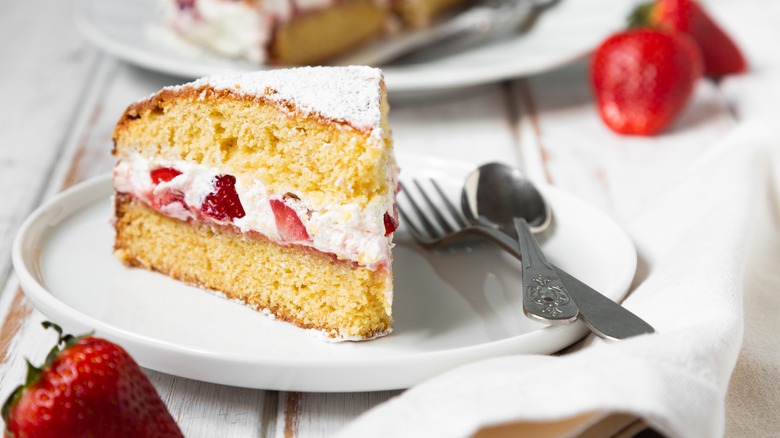The Flour Tip You Need To Remember For A Beautifully Soft Victoria Sponge Cake
Victoria sponge cake is known for its light fluffiness and traditional fruit-and-cream filling. Its creation is credited to Anne Russell, the seventh Duchess of Bedford, in the late 1800s — or more specifically, her kitchen staff. The duchess served a slice to the visiting Queen Victoria, who liked the sponge cake so much, it now bears her name and has been a teatime staple in England and elsewhere ever since.
This delicate cake is deceptively easy to make. The trick to making a light-as-air Victoria sponge is to sift your flour thoroughly before adding it to the rest of the cake ingredients. Flour lumps can result in a denser texture that can be unpleasant to eat, which is not what you want when creating the famous Victoria sponge.
When the cake is done baking, it should spring back when touched, hence the so-called 'sponge' texture. If your cake doesn't have that iconic spring, although its taste might still be great, you may want to go back to the drawing board.
The history of the Victoria sponge cake
The Victoria sponge cake, loved around the world for its simplicity, uses self-rising flour — no additional leaveners required — and just a few other basic ingredients. It's the thorough sifting that gives the cake its fluffy, springy sponginess.
There are several effective ways to sift flour for this type of cake. You can use a fine mesh strainer and gently tap the sides; a flour sifter; whisk flour in a large bowl with a metal whisk; or use a fork to stir and fluff your flour. Keep in mind that using a whisk or a fork won't remove any impurities that might be in the flour. The best way to sift flour is to use a small strainer or flour sifter. Be sure to measure the flour again after sifting. Because the texture of this cake is so delicate, using a kitchen scale to ensure precise measurements is recommended.
Most of the commercial flour in the U.S. is mechanically sifted and doesn't require further sifting unless you are making a delicate cake such as a sponge or angel food. Even if the recipe doesn't specify sifting the flour, it's a good idea to at least stir the bag of flour before measuring it so that the flour is not too compacted. If the flour you are using has been sitting in a large bag for a while, sifting it to get rid of any possible lumps is a better idea.
Uses for Victoria sponge cake
Victoria sponge cake is traditionally made in circular or square layers, with jam and cream between each layer, and served sliced. It is also popular served as a bite-sized cake. But this sponge has several uses, such as being an ideal cake for making a trifle. If you choose to make a whole Victoria sponge, know that it can be challenging to cut the layers as they are very fragile.
Also, make sure you use heavy cream — not milk — to produce this cake, as the fat in the cream will make a difference to the overall texture of the cake. In the end, what matters most when creating a Victoria sponge is sifting your flour before making the cake. Sifting will create that delicate and delicious cake crumb that's been cherished for decades! If you've never made a Victoria sponge, this is a cake to add to your list of recipes to try–and it's one that almost everyone will love.


